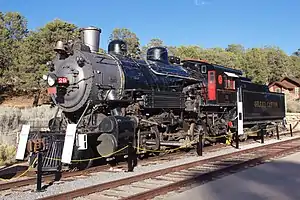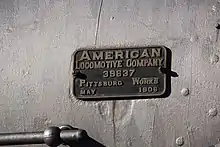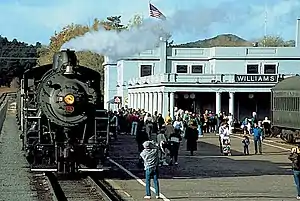Grand Canyon Railway 29
Grand Canyon Railway No. 29 is the sole survivor of the class "SC-3" 2-8-0 "Consolidation" type steam locomotives. It was built by the American Locomotive Company (ALCO) in Pittsburgh, Pennsylvania in May 1906 for use in hauling carloads of iron ore on branch lines of the Lake Superior and Ishpeming Railroad as engine No. 14, and was renumbered 29 in 1923. It was retired from revenue service in 1956. In 1963, it was sold to the Marquette and Huron Mountain Railroad, but never run there. Today, it resides at the Grand Canyon Railway as a running mate to 2-8-2 No. 4960. As of 2020, though, it is going through a 1,472-day FRA boiler inspection.
| Grand Canyon Railway 29 | |||||||||||||||||||||||||||||||
|---|---|---|---|---|---|---|---|---|---|---|---|---|---|---|---|---|---|---|---|---|---|---|---|---|---|---|---|---|---|---|---|
 GCRY No. 29 on static display at the Grand Canyon Village in 2015 | |||||||||||||||||||||||||||||||
| |||||||||||||||||||||||||||||||
| |||||||||||||||||||||||||||||||
| |||||||||||||||||||||||||||||||
| |||||||||||||||||||||||||||||||
History
Original Service Life

In the 1900s, the Lake Superior and Ishpeming railroad[1] needed locomotives to pull passenger and iron ore trains between West Ishpeming and Marquette.[2] They had a group of 2-8-0 consolidation types at the time, including two class B-4s built in 1902, which were rated at approximately 43,304 pounds of tractive effort, but the railroad decided they needed bigger locomotives to get the heavy work done faster. Thus, in 1906, the railroad ordered a new design of a 2-8-0 consolidation[3] from the American Locomotive Company (ALCO) in Pittsburgh, Pennsylvania, a slightly different class B-4 to replace an 1880s-built 0-4-0. That B-4 was No. 29, which was numbered 14 at the time. When it arrived, it bore the brunt of ore hauling, as it pounded up a %1.6 grade between Marquette and Negaunee, pulling 45 loaded hopper cars, making it the most powerful consolidation ever built at that time. The same thing can said for the 1902-built B-4s, 15 and 16.
In 1909, the railroad ordered five more 2-8-0 locomotives from ALCO, and they arrived the following year, being numbered 9-13. The newer locomotives had smaller boilers than the B-4, and they were not quite as powerful, either, as they were only capable of 34,000 pounds in tractive effort. However, they were still capable for mixed services. When the Pittsburg facility was shut down, and as World War I broke out, the LS&I decided to get locomotives larger and more powerful than what they had, so they ordered three larger locomotives from Baldwin Locomotive Works, and they were numbered 18-20. With these “Hogs” being capable of 55,900 pounds and having the ability of pulling 60 loaded cars, they stole the B-4's title as the largest and most powerful consolidation ever built. In fact, the 14 was possibly reassigned as a dock switcher in the docks of Marquette. Either way, it was transferred to the Marquette division, especially after being involved in a wash-out wreck roughly two months after the hogs arrived.
In 1924, the LS&I received some additional 2-8-0s, after purchasing the Munising, Marquette and Southeastern Railway, so a renumbering system and reclassification system were in order; the B-4s were reclassified as SC-3s and were renumbered 16-17, as well as 25-29, 9-13 were reclassified as SC-4s and renumbered 18-25, and the hogs were reclassified as SC-1s while being renumbered 32-35. The 14 was renumbered 29, and the number 14 was given to a 2-8-2 Mikado the railroad had purchased from the bankrupt Duluth and Northern Minnesota Railroad.[4] In 1925, the 29 was sent to the Presque Isle shops to be heavily rebuilt with modified cylinders, disk pilot wheels, and a slightly wider firebox. These modifications have improved the locomotive’s performance, especially when it received some booster trucks under the front of its tender, in 1934. The husky consolidation has resumed on mixed and heavy ore trains in the Ishpeming region, until even the LS&I decided to fully dieselize by the early 1960's. No. 29 was retired in 1956, and it was stored as an emergency back up inside an auxiliary roundhouse.
In 1963, the railroad sold twelve of their consolidations, as well as some of their passenger cars, to the Marquette and Huron Mountain Tourist Railroad.[5] This was intended to give the old consolidations another chance on life for use in excursion service. However, there are no known records of the 29 pulling any trains for that railroad. Only some of its distant sister engines, Nos 19, 22, 23, and 24, were known to pull tourist trains there between Marquette and Big Bay.[6] Instead, No. 29 sat with the rest of the 2-8-0s in the form of a 'scrapline', facing an uncertain future. The M&HM was shut down in 1984 when the line's owner passed away, and the remnants of their active roster were also retired.
In 1985, No. 29 was among a few of the 2-8-0s that were sold to the Ishpeming Steel Company for storage. Just a few months later, it was sold again to the Mid-Continent Railway Museum[7] in North Freedom, Wisconsin for static display. Not to be confused with Copper Range 2-8-0 No. 29.[8]
Grand Canyon Railway

In 1988, the Grand Canyon Railway,[9] a former Atchison Topeka & Santa Fe branch line that ran between Williams, Arizona and the South rim of the Grand Canyon National Park, was bought by Max and Thelma Biegert, a couple from Phoenix. The first locomotives the new company purchased were four Ex-LS&I 2-8-0s; 18, 19, 20, and of course, 29. At first, only No. 18 was planned to be used in excursion service on the new tourist line, while the rest were only planned to be display pieces. However, No. 29 was also going through an operational restoration of its own, which only took one year. It was converted to oil firing, the booster trucks under its tender were removed, and its headlight was relocated to the center of the smokebox door along with the bell on top. It went through a rolling test in January 1990,[10] and a couple months later, it was test fired and moved under its own power for the first time in thirty-four years. Despite No. 18 being the first steam locomotive to be fired up on the GCRY in September 1989, No. 29 pulled the first public train in sixteen years, when it fully returned to operation itself in April of 1990.[11] No. 29 ran excursion runs between Williams and the Grand Canyon Village for the GCRY for five years in the 1990s.
.jpg.webp)
In 1995,[12] No. 29 was taken out of service, and sometime later, it was stored in the locomotive shops, where it received a thorough overhaul that lasted until 2004. In that said overhaul, No. 29 got a pipeline cowcatcher and was given a dual beam headlight, just like what the railway gave former Chicago Burlington and Quincy 2-8-2 No. 4960. Shortly afterwards its smokestack diameter was enlarged by a few inches. In 2005, the 29 and 4960 performed a double header between Williams and the Grand Canyon Village, as well as a night photo session with the two steamers side by side in front of the old log depot. From 2004-2008, No. 29 resumed its career as a tourist locomotive, and during that same timeframe, a new Worthington feedwater heater was installed, thus making the 29 the World’s only 2-8-0 to ever support a feedwater heater. By 2008, all of No. 29's distant sister engines on the railway were sold off. No. 19 was already sold[13] in 1993 to the MGM Grand Adventures Theme Park in Las Vegas, Nevada and it was eventually sold again to the city of Frisco, Texas for static display as a Frisco engine. In 2007, the GCRY purchased Ex-Spokane Portland and Seattle 2-8-2 No. 539 from Brian Fleming,[14] and in exchange, Nos 18 and 20 were transferred to the Mount Hood Railroad in Oregon before being sold again to the Rio Grande Scenic Railroad[15] in Alamosa, Colorado, where No. 18 is put up for sale.[16] No. 20 was sold to the City of Allen, Texas, where it also stays put with Frisco lettering.
Beginning in 2009, after the entire GCRY was purchased by Xanterra Travel Collection, steam operations became limited on when they could run. Meanwhile, the last consolidation on the GCRY remained on static display in front of the Williams depot[17] for the next five years. Sometimes, during Christmas, it would often be re-lettered Polar Express[18] while still on display at Williams. In 2014, the 29 was moved to the GCV Log depot, where it remained on display for one more year.[19] In 2016, No. 29 was fired up again and performed another double header with the 4960 for the centennial of the National Park Service.[20] For another three years, the 29 ran a few more excursions for the GCRY, until October 27, 2019,[21] when the locomotive was placed in storage inside the shops for more time out of service. As of 2020, the 29 is going through a mandated 1,472-day boiler inspection required by the Federal Railroad Administration (FRA).[22]
Accidents and incidents
- On June 2, 1916, when the 29 was numbered 14, it figured in a wash-out wreck while coming down from Negaunee with an iron ore train.[23] The locomotive and several hopper cars rolled down on their sides on a steep embankment. The possible cause of this derailment was the fact it was heavily raining in many Northern Midwest areas that day. It took about a month to get the 14 "on its pins" again, meaning the 14 was brought back to service after some repairs were done. It is unclear if the engineer, fireman, or leading brakeman were injured or killed.
See also
External links
References
- Durocher, Aurele A. (1958). "The Lake Superior and Ishpeming Railroad Company". The Railway and Locomotive Historical Society Bulletin (98): 7–31. ISSN 0033-8842.
- "Lake Superior & Ishpeming Railroad: History/Map/Photos". American-Rails.com. Retrieved 2020-11-14.
- "Lake Superior & Ishpeming 2-8-0 "Consolidation" Locomotives in the USA". www.steamlocomotive.com. Retrieved 2020-11-30.
- "Steam Locomotive Information". www.steamlocomotive.info. Retrieved 2020-12-20.
- "Marquette & Huron Mountain Railroad". www.railroadmichigan.com. Retrieved 2020-11-14.
- "Old_MHM". algomacentral.railfan.net. Retrieved 2020-12-20.
- "You searched for ishpem". Mid-Continent Railway Museum. Retrieved 2020-12-02.
- "Copper Range #29". Mid-Continent Railway Museum. Retrieved 2020-12-03.
- "Grand Canyon Railway". Grand Canyon Railway. Retrieved 2020-11-14.
- "GCRY 29's return to service! - YouTube". www.youtube.com. Retrieved 2020-12-02.
- "History of Grand Canyon Railway | Grand Canyon Railway & Hotel". Grand Canyon Railway. Retrieved 2020-11-17.
- "GCRY 29". www.rrpicturearchives.net. Retrieved 2020-11-17.
- GmbH, Emporis. "Exhibition of a steam engine in an open mini theme park during the 1990's, MGM Grand Resort & Casino, Las Vegas | Image 322651". www.emporis.com. Retrieved 2020-12-05.
- "Mount Hood Railroad | Scenic Train Rides & Tours in Hood River, OR". Mt. Hood Railroad. Retrieved 2021-01-09.
- "Rio Grande Scenic Railroad". www.facebook.com. Retrieved 2020-11-17.
- "Lake Superior & Ishpeming Railroad 2-8-0 #18 FOR SALE/LEASE – Ozark Mountain Railcar". Retrieved 2020-11-18.
- "Train Depots | Grand Canyon Railway & Hotel". Grand Canyon Railway. Retrieved 2020-11-17.
- Blufish (2014-08-20). "Tickets to the Polar Express Now on Sale". AZ Big Media. Retrieved 2020-12-04.
- "Moving Steam Locomotive No. 29 to Grand Canyon Depot - YouTube". www.youtube.com. Retrieved 2020-11-17.
- "NPS.gov Homepage (U.S. National Park Service)". www.nps.gov. Retrieved 2020-11-17.
- May 28; 2019. "Trains, Grand Canyon Railway to run Consolidation No. 29 on October photo event | Trains Magazine". TrainsMag.com. Retrieved 2020-11-17.CS1 maint: numeric names: authors list (link)
- "| FRA". dotcms.fra.dot.gov. Retrieved 2020-11-17.
- "Untitled Document". www.viewsofthepast.com. Retrieved 2020-12-20.
